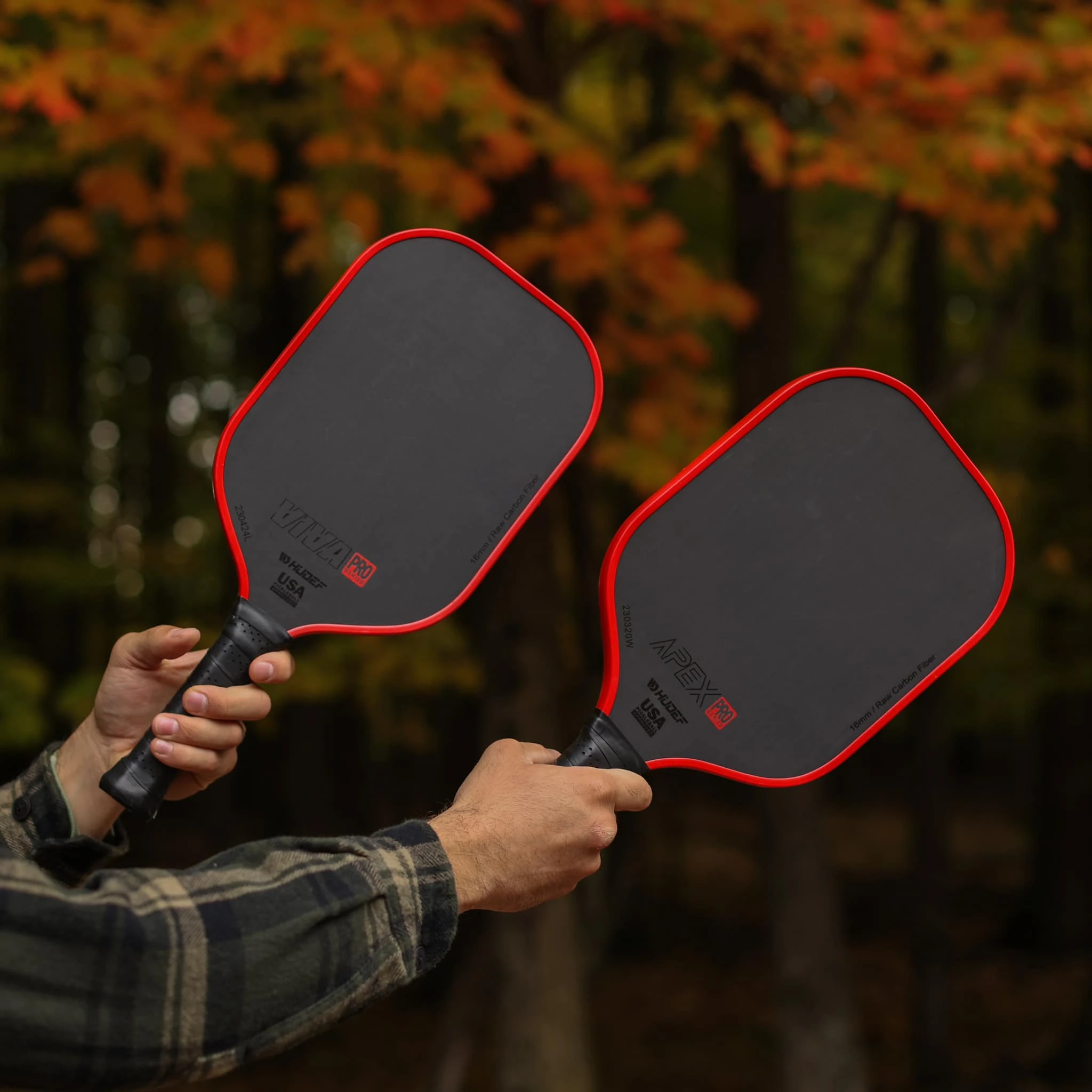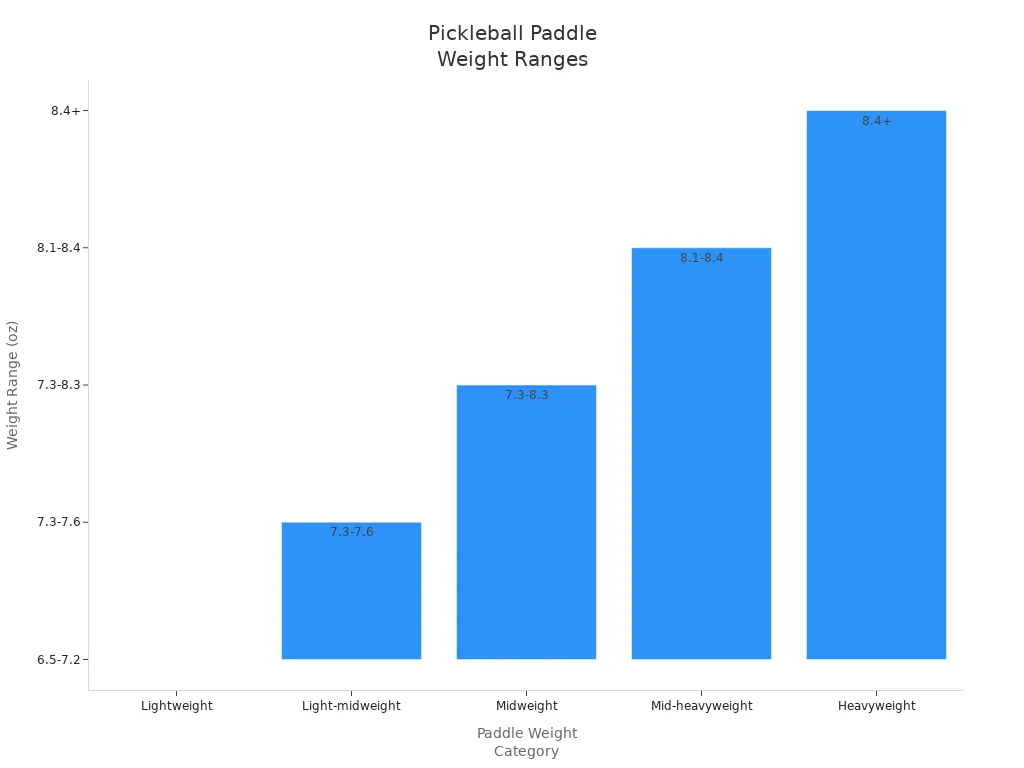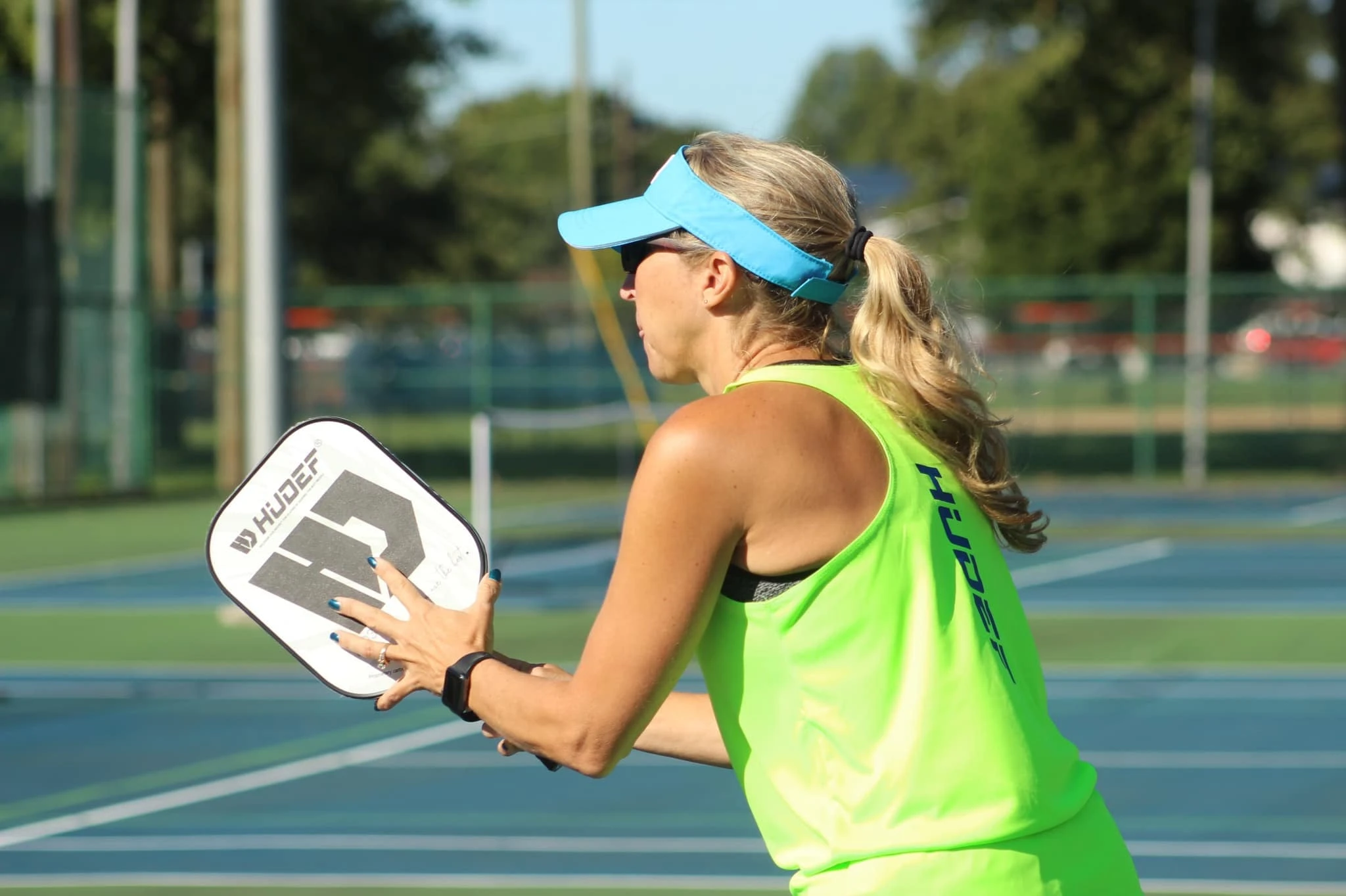
You get strong power when you use a professional heavy pickleball paddles weapon. Good quality is important in every game. You want control, strength, and a big sweet spot. Hudef gives you a pickleball paddle made for serious play. Good build and new technology in pickleball paddles make you stand out from others.
Key Takeaways
-
Heavy pickleball paddles help you hit harder shots. They also help you hit faster shots. This can help you win more games. Heavy paddles give you more power and steadiness.
-
Pick a paddle weight that fits your play style. Make sure the paddle feels comfortable in your hand. Try to balance power, control, and grip. This helps you play your best.
-
Clean your paddle often to keep it nice. Store your paddle in a safe place. Replace old or broken parts when needed. This helps you play well and stay safe.
Why Heavy Paddles Are Weapons
Power and Aggression
You want to hit the ball hard and fast. A professional heavy pickleball paddles weapon helps you do this. When you swing a heavier paddle, you give more energy to the ball. Lab tests show that every 5 kg·cm² more swingweight makes the ball go about 0.8 mph faster. This means your shots move quicker and go farther. Your opponent has less time to react. Paddle makers use new ways like thermoforming and foam injection to make paddles heavier and stiffer. You can also put lead tape on the paddle head for extra power. Many players who want strong shots pick heavy paddles. These paddles help you hit hard and win more rallies.
Tip: If you like hitting hard, try adding some weight to your paddle head. You will see your shots get faster.
Control and Precision
You need control to put the ball where you want. Heavy paddles help you keep your shots steady. This is helpful when you play against strong hitters. Professionals say paddle weight changes both control and power. Heavy paddles give you more stability. You might need to change how you play at the net. Many top players use midweight paddles for a mix of power and control. If you want the best control, look for paddles with smart weight balance and textured faces. These features help you spin and aim the ball better. You can also change the grip and weight to fit your style. This helps you stay accurate in every point.
-
Heavy paddles give more power and steadiness, but can be harder to move.
-
Midweight paddles give both power and control, so many pros use them.
Competitive Edge
You want to win more games. Heavy paddles give you a real boost. Advanced players often pick heavy paddles for their power and bigger sweet spots. You get more help if you do not hit the center of the paddle. This means you make fewer mistakes. Coaches say paddles between 7.9 and 8.2 ounces are good for speed and strength. Shock absorption and vibration reduction help you play longer without pain. When you use the best paddle for power, you can push your opponent back. You can also control how fast the game goes. The best paddles for power and control help you play well in any situation. You feel more sure of yourself and play your best.
Note: Many pros say it takes time to get used to a heavier paddle, but the extra power and steadiness are worth it.
Key Features of Professional Heavy Pickleball Paddles Weapon
Weight and Balance
It is important to know how paddle weight changes your game. Most professional heavy pickleball paddles weapon weigh between 7.3 and 8.4 ounces. Heavier paddles give you more power and help keep your shots steady. Lighter paddles are easier to move and help you control the ball better. The balance point tells you how the paddle feels in your hand. It also affects how fast you can swing and react. Paddle makers work hard to make the balance just right. This helps you swing quickly and hit hard without losing control.
|
Paddle Weight Category |
Weight Range (oz) |
Impact on Balance and Play Style |
|---|---|---|
|
Lightweight |
< 7.2 |
Focuses on control and skill; less power; easy to move |
|
Midweight |
7.3 - 8.3 |
Mix of power and control; good for most players; steady and accurate |
|
Heavyweight |
8.4+ |
Gives most power and steadiness; less control; can make you tired |

Pick a paddle weight that fits how you play. If you want strong hits, use a heavier paddle. If you like quick moves, pick a lighter one. Many players choose midweight paddles because they give both power and control.
Core Thickness and Sweet Spot
The thickness of your paddle’s core is very important. Thick cores, about 16mm, make the sweet spot bigger and easier to hit. This helps you hit the ball well, even if you miss the center. New technology like honeycomb core and special layers make the sweet spot up to 35% larger. Thermoformed paddles use heat and pressure to make the sweet spot work better all over the paddle.
-
Thick cores soak up more energy, so your arm feels less shock.
-
If you hit off-center, thick cores still give you strong shots.
-
Unibody paddles and foam edges make the paddle steadier and the sweet spot bigger.
You get more control, less shaking, and a lower chance of getting hurt. Heavy paddles with thick cores are good for tough games because they are strong and forgiving.
Tip: Choose paddles with honeycomb core and special layers if you want a bigger sweet spot and more control.
Surface Material and Texture
The paddle’s surface changes how much spin you get and how long it lasts. Most professional heavy pickleball paddles weapon use carbon fiber, graphite, or composite materials. Carbon fiber is the best choice for top paddles. It feels soft, has a big sweet spot, and helps you spin the ball. Raw carbon fiber faces keep their spin longer than painted or rough surfaces.
-
Carbon fiber: Best for spin, lasts long, and gives good control.
-
Graphite: Good for soft shots and control; not as forgiving but steady.
-
Composite: Strong and powerful; rough surface for spin but smaller sweet spot.
Tiny textures on the paddle make the ball touch more of the surface, which helps with spin and control. Special coatings and anti-UV layers keep the paddle safe from sun and damage. Your paddle will stay strong and look good, even after many games. You can use these paddles inside or outside without worrying about them wearing out fast.
Note: Paddles with top materials and coatings last longer and work better, so they are a smart buy for serious players.
Handle and Grip Comfort
A comfy grip is important for long games and to stop injuries. The best paddles have handles made from soft leather, rubber, or silicone. These materials feel nice, bend easily, and do not slip. Silicone grips fit your hand and help absorb shocks. Big grips, about 4-1/2 inches, help keep your hand from getting tired, especially if your hands are large.
Makers add gel inside the handle and soft guards on the edge to stop shaking and protect your wrist and elbow. Hexagon-shaped grips help you hold the paddle without squeezing too hard. The right grip size keeps your hand from hurting and helps you play longer.
-
Grips shaped for your hand help you stay steady and not get tired.
-
Shock-absorbing grips and edge guards stop shaking and help prevent injuries.
-
Pick a grip size that fits your hand for the best comfort and control.
Tip: Always try the grip before you buy a paddle. The right handle can help you play better and have more fun.
Best Pickleball Paddles for Power and Control

hudefsport Weapon Series
The hudefsport Weapon Series is made for top play. It has a special shape and floating core. The sweet spot is much bigger than most paddles. You feel less shaking because of the honeycomb polymer core. Shock-absorbing layers in the handle help your hand. The carbon fiber face is textured. This helps you control spin and where the ball goes.
-
The big sweet spot gives you more power and helps if you miss.
-
Foam edge wall and edge guard keep the paddle safe and strong.
-
The handle fits your hand and gel inserts help your hand not get tired. This paddle works well for long games and hard rallies.
Selkirk Power Air
Selkirk Power Air is great for power, spin, and quick moves. The surface feels rough like sandpaper. It lasts a long time and helps you spin the ball. The paddle is light and easy to move fast at the net.
-
It gives strong power and spin, good for singles and fast games.
-
The sweet spot is medium, so you need to aim well.
-
It is tough but may feel stiff at first. This paddle is good for players who want strong shots and fast hands.
Paddletek Tempest Wave Pro
The Tempest Wave Pro gives you control and good quality. The honeycomb core is 14.3mm thick. It soaks up energy and lowers shaking and arm pain. The PT-700 raw carbon fiber face helps you spin the ball and hit the sweet spot.
-
It feels soft and soaks up power.
-
The sweet spot is big, so your shots are steady.
-
The handle feels like a tennis grip and is comfy. This paddle is great for players who want control and a paddle that lasts.
Onix Evoke Premier
The Onix Evoke Premier gives you power and less shaking. You can pick the weight that fits your style. Atomic13 Edge Technology and DF Composite face lower shock and help you hit hard.
-
The shape is big, so the sweet spot is larger.
-
It gives strong power and quick hits.
-
It is good for players who want control and a strong paddle. This paddle is one of the best for power hitters who want comfort and speed.
How to Choose the Right Heavy Paddle
Assessing Your Play Style
You need to know your play style before picking a heavy pickleball paddle. If you like strong, fast shots, a paddle with higher swingweight gives you more power. Swingweight above 118 means the paddle feels heavier in your hand and helps you hit harder. If you want more control, look for a paddle with a thicker core and a larger sweet spot. Twistweight tells you how stable the paddle feels when you miss the center. A higher twistweight means more forgiveness. Think about your comfort, too. Some players prefer a lighter paddle for quick moves, while others want a heavier one for power.
-
Paddle Weight: Heavier paddles give power; lighter paddles help with control.
-
Core Material: Polymer cores are quiet and easy to control. Nomex cores give more power.
-
Surface Texture: Textured paddles help you spin the ball.
-
Grip Size: The right grip keeps your hand comfortable and steady.
Matching Features to Needs
You should match paddle features to your skill level and goals. Beginners often do best with lighter or midweight paddles that have a big hitting area. These paddles are the best for beginners because they help you learn control and make good contact. If you want the best budget paddle, look for composite paddles that balance price and performance. Intermediate players often choose midweight paddles for better spin and strategy. Advanced players may want a heavier graphite paddle for more power and precision. The best bang for your buck comes from paddles that fit your style and last a long time.
|
Player Level |
Paddle Type |
Why It Works |
|---|---|---|
|
Beginners |
Lightweight, large surface |
Best for beginners; easy to control |
|
Intermediate |
Composite, midweight |
Best budget paddle; good for strategy |
|
Advanced |
Heavy graphite/composite |
Power and precision |
Tip: The best gear to start is a paddle that feels comfortable and helps you play your best.
Testing and Evaluation
You should always test paddles before you buy. Try different weights and grip sizes to see what feels right. Ask friends if you can try their paddles or use a store’s demo program. Many brands offer a 30-day trial so you can play at home. When you test, pay attention to how often you hit the sweet spot. If you miss a lot, try a paddle with a bigger sweet spot. Use tools like Paddle Guide if you cannot test many paddles in person. Testing helps you find the best for beginners or the best budget paddle for your needs.
Practical Tips for Heavy Paddle Users
Injury Prevention
You can protect yourself from common injuries by using the right techniques and preparing your body. Heavy paddles add strain to your arm and shoulder if you do not use proper form. The table below shows the most common injuries and how you can prevent them:
|
Injury Type |
Cause Related to Heavy Paddles or Play |
Prevention Strategies |
|---|---|---|
|
Pickleball Elbow |
Repetitive swinging, overuse of forearm muscles |
Use paddles with shock absorption, warm up, adjust technique, strengthen forearm |
|
Wrist or Hip Fractures |
Falls from loss of balance on hard courts |
Train balance, wear stable shoes, move with care |
|
Rotator Cuff Injury |
Overuse, poor swinging technique |
Improve technique, use hips and trunk, stretch shoulders, rest if sore |
|
MCL Strain |
Quick lateral moves, twisting knee |
Strengthen knee muscles, do squats/lunges, stretch, practice balance |
|
Achilles Tendon Injury |
Quick push-offs, landing from jumps |
Warm up, strengthen Achilles, balance exercises, wear proper footwear |
Tip: Always warm up before you play and listen to your body. Good technique and strong muscles help you avoid injuries.
Maintenance and Care
You want your paddle to last and perform well. Follow these steps to keep your paddle in top shape:
-
Clean your paddle after each game with mild soap and warm water. Avoid harsh chemicals.
-
Store your paddle in a cool, dry place. Keep it away from heat, humidity, and sunlight.
-
Replace grips and edge guards when they show wear. This keeps your grip strong and protects the paddle.
-
Do not over-tighten screws. Use locking mechanisms if screws loosen often.
-
Fix small scratches or chips right away. Use gentle sanding or epoxy, or get professional help if needed.
Keeping your paddle clean and protected helps you play better and extends its life.
When to Upgrade
You should watch for signs that your paddle needs replacing. Look for these issues:
-
Dead spots that make your shots weak or unpredictable.
-
Cracks, deep chips, or worn surfaces that affect ball contact.
-
Slippery, frayed, or loose grips and handles.
-
Strange sounds or vibrations during play.
-
Loss of surface grit, making it hard to control the ball.
-
Loose or damaged edge guards.
-
Trouble hitting routine shots, even with good form.
If you notice these problems, check your paddle’s warranty. Upgrading to a new paddle keeps your game sharp and safe.
New paddle technology helps you play better. Carbon fiber and honeycomb cores give you more power and control. You also feel more comfortable when you play.
|
Technology |
Benefit |
|---|---|
|
Strong shots, less shaking |
|
|
Honeycomb Core |
Bigger sweet spot, more steady |
-
Test different paddles and buy a good one for better games.
FAQ
What weight paddle should you choose for power and control?
You should select a paddle between 7.9 and 8.4 ounces. This range gives you strong power and steady control for most competitive games.
How do you reduce vibration when using a heavy paddle?
Look for paddles with shock-absorbing handles, honeycomb cores, or gel inserts. These features help you play longer and protect your arm.
How often should you replace your pickleball paddle?
You should replace your paddle every 12 to 24 months. Check for dead spots, cracks, or worn surfaces that affect your game.















